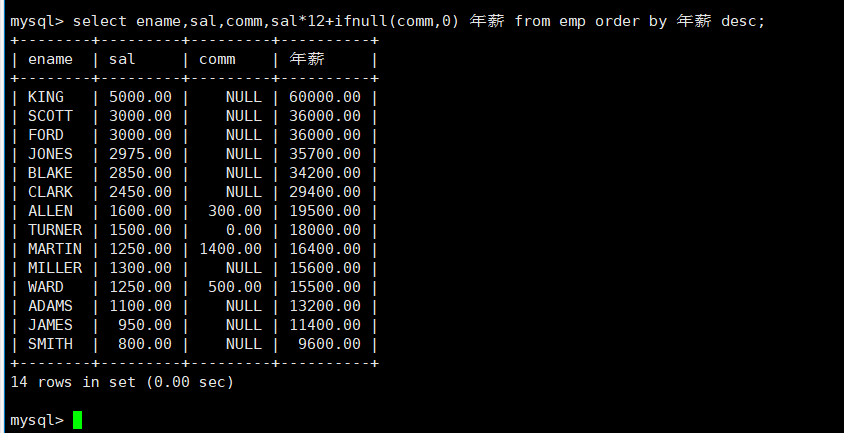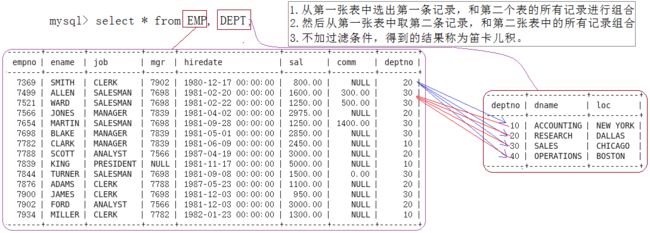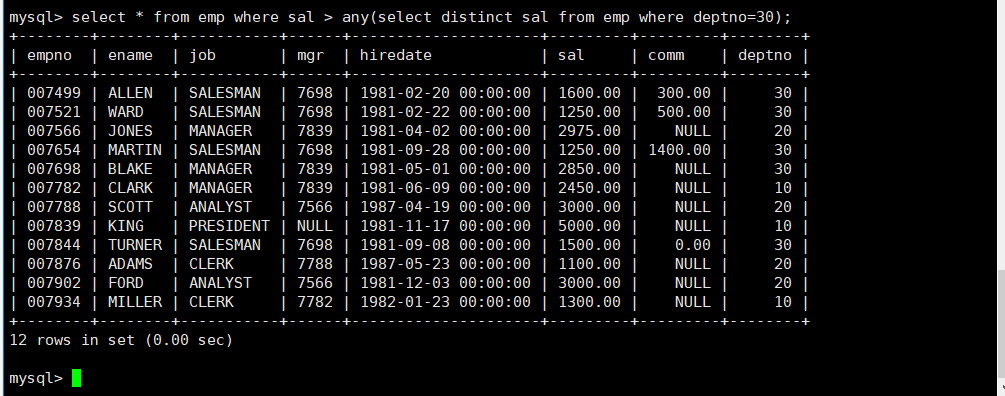【MySql】复合查询
文章目录
- 回顾基本查询
- 多表查询
- 自连接
- 子查询
- 合并查询
- OJ题目
前面我们讲解的mysql表的查询都是对一张表进行查询,在实际开发中这远远不够。
回顾基本查询
回顾一下前面所学的基本查询,通过一些案例来练习回顾:
- 查询工资高于500或岗位为MANAGER的雇员,同时还要满足他们的姓名首字母为大写的J
select * from emp where (sal>500 or job='MANAGER') and ename like 'J%';
select * from emp where (sal>500 or job='MANAGER') and substring(ename,1,1)='J';
- 按照部门号升序而雇员的工资降序排序
select * from emp order by deptno asc,sal desc;
- 使用年薪进行降序排序
select ename,sal,comm,sal*12+ifnull(comm,0) 年薪 from emp order by 年薪 desc;
- 显示工资最高的员工的名字和工作岗位
select * from emp where sal=(select max(sal) from emp);
- 显示工资高于平均工资的员工信息
select * from emp where sal > (select avg(sal) from emp);
- 显示每个部门的平均工资和最高工资
select deptno, max(sal)最高,format(avg(sal),2) 平均 from emp group by deptno;
- 显示平均工资低于2000的部门号和它的平均工资
select deptno,avg(sal) 平均工资 from emp group by deptno having avg(sal)<2000;
-- select deptno,avg(sal) 平均工资 from emp group by deptno having 平均工资<2000;
- 显示每种岗位的雇员总数,平均工资
select job,count(*) 人数,format(avg(sal),2) 平均工资 from emp group by job;
多表查询
实际开发中往往数据来自不同的表,所以需要多表查询。现在我们用三张表EMP,DEPT,SALGRADE来演示多表查询。
- 显示雇员名、雇员工资以及所在部门的名字
因为上面的数据来自EMP和DEPT表,因此要联合查询
将数据进行穷举组合——就是笛卡尔积,此时可以理解为把两张表变成了一张表
select ename,sal,dname from emp,dept where emp.deptno=dept.deptno;
- 显示部门号为10的部门名,员工名和工资
select ename,sal,dname from emp,dept where emp.deptno=dept.deptno and emp.deptno=10;
- 显示各个员工的姓名,工资,及工资级别
select ename,sal,grade,losal,hisal from emp,salgrade where sal between losal and hisal;
自连接
自连接是指在同一张表连接查询
举个例子:
- 显示员工FORD的上级领导的编号和姓名(mgr是员工领导的编号–empno)
想找FORD的领导的编号,通过EMP表;根据领导的编号,找领导信息,也是通过EMP表:
使用的子查询
select ename,empno from emp where empno=(select mgr from emp where ename='FORD');
使用多表查询(自查询):
select e2.ename,e2.empno from emp e1,emp e2 where e1.ename='FORD' and e1.mgr=e2.empno;
子查询
子查询是指嵌入在其他sql语句中的select语句,也叫嵌套查询
单行子查询
返回一行记录的子查询
- 显示SMITH同一部门的员工
select * from emp where deptno=(select deptno from emp where ename='SMITH');
多行子查询
返回多行记录的子查询
- in关键字;查询和10号部门的工作岗位相同的雇员的名字,岗位,工资,部门号,但是不包含10自己的
select ename,job,sal,deptno from emp where job in (select distinct job from emp where deptno=10) and deptno <> 10;
如果此时还想知道对应的员工属于哪个部门的名字呢?
select ename,job,sal,dname from (select ename,job,sal,deptno from emp where job in (select distinct jobb from emp where deptno=10) and deptno <> 10) as tmp,dept where dept.deptno=tmp.deptno;
- all关键字;显示工资比部门30的所有员工的工资高的员工的姓名、工资和部门号
第一种做法:
select * from emp where sal > (select max(sal) from emp where deptno=30);
第二种做法:
select * from emp where sal>all(select distinct sal from emp where deptno=30);
- any关键字;显示工资比部门30的任意员工的工资高的员工的姓名、工资和部门号(包含自己部门的员工)
select * from emp where sal > any(select distinct sal from emp where deptno=30);
多列子查询
单行子查询是指子查询只返回单列,单行数据;多行子查询是指返回单列多行数据,都是针对单列而言的,而多列子查询则是指查询返回多个列数据的子查询语句
- 查询和SMITH的部门和岗位完全相同的所有雇员,不含SMITH本人
select * from emp where (deptno,job) = (select deptno,job from emp where ename ='SMITH') and ename <>'SMITH';
-- select * from emp where (deptno,job) in (select deptno,job from emp where ename ='SMITH') and ename <> 'SMITH';
我们前面说了,任何时刻,查询出来的临时结构,本质在逻辑上也是表结构!
我们上面的子查询全部都是在where子句中,充当判断条件。
下面,我们来看一看在from子句中使用子查询。
在from子句中使用子查询
子查询语句出现在from子句中。这里要用到数据查询的技巧,把一个子查询当做一个临时表使用。
- 显示每个高于自己部门平均工资的员工的姓名、部门、工资、平均工资
select * from emp,(select deptno,avg(sal) myavg from emp group by deptno) tmp where emp.deptno=tmp.deptno and emp.sal> tmp.myavg;
- 查找每个部门工资最高的人的姓名、工资、部门、最高工资
select ename,sal,t1.deptno,mymax from emp t1,(select deptno,max(sal) mymax from emp group by deptno) t2 where t1.deptno = t2.deptno
and t1.sal=t2.mymax;
- 显示每个部门的信息(部门名,编号,地址)和人员数量
select t1.dname,t1.loc,t2.dept_num,t1.deptno from dept t1,(select deptno, count(*) dept_num from emp group by deptno) t2 where t1.deptno=t2.dtno=t2.deptno;
合并查询
在实际应用中,为了合并多个select的执行结果,可以使用集合操作符 union,union all
union
该操作符用于取得两个结果集的并集。当使用该操作符时,会自动去掉结果集中的重复行
- 将工资大于2500或职位是MANAGER的人找出来
select * from emp where sal > 2500 union select * from emp where job='MANAGER';
union all
该操作符用于取得两个结果集的并集。当使用该操作符时,不会去掉结果集中的重复行。
select * from emp where sal > 2500 union all select * from emp where job='MANAGER';
OJ题目
查找所有员工入职时候的薪水情况
描述
查找所有员工入职时候的薪水情况,给出emp_no以及salary, 并按照emp_no进行逆序(请注意,一个员工可能有多次涨薪的情况)
CREATE TABLEemployees(
emp_noint(11) NOT NULL,
birth_datedate NOT NULL,
first_namevarchar(14) NOT NULL,
last_namevarchar(16) NOT NULL,
genderchar(1) NOT NULL,
hire_datedate NOT NULL,
PRIMARY KEY (emp_no));
CREATE TABLEsalaries(
emp_noint(11) NOT NULL,
salaryint(11) NOT NULL,
from_datedate NOT NULL,
to_datedate NOT NULL,
PRIMARY KEY (emp_no,from_date));输入描述:
无
select s.emp_no,s.salary from salaries s,employees e
where e.emp_no=s.emp_no and e.hire_date=s.from_date
order by e.emp_no desc;

























